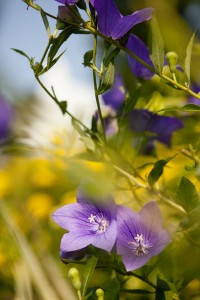NYBG Scientists Rewrite Conservation
Posted in NYBG in the News on August 29 2012, by Matt Newman
 Go out into your back yard (assuming you have one) and pretend you have to not only identify, but describe, designate, and catalog every plant that’s growing there. Now multiply that challenge by the entire surface of the Earth, and you’re standing in a botanist’s shoes. Of course, it’s not going to be as easy as all that; as a plant scientist, you’re also racing against a clock that stubbornly speeds up with each passing year. Climate change, human development, and myriad other influences are wiping out species before you’re even aware they’re under threat–and there are hundreds of thousands of species to account for. Worse, the system you use to designate these plants as endangered isn’t exactly marching to the beat of your own drum.
Go out into your back yard (assuming you have one) and pretend you have to not only identify, but describe, designate, and catalog every plant that’s growing there. Now multiply that challenge by the entire surface of the Earth, and you’re standing in a botanist’s shoes. Of course, it’s not going to be as easy as all that; as a plant scientist, you’re also racing against a clock that stubbornly speeds up with each passing year. Climate change, human development, and myriad other influences are wiping out species before you’re even aware they’re under threat–and there are hundreds of thousands of species to account for. Worse, the system you use to designate these plants as endangered isn’t exactly marching to the beat of your own drum.
This is where The New York Botanical Garden‘s experts step in, with a new system that could turn a challenging outlook for botanical conservationists into a bright future.
Back in January, James S. Miller, Ph.D., Dean and Vice President for Science at the Garden, announced a revolutionary change in the way botanical science is handled. Rather than requiring all newly-discovered plants to be described in Latin, a tedious process unchanged since the days of Linnaeus, taxonomists are now welcome to submit their work in modern English. This goes a long way to breaking up the botanical traffic jam, evening out the speed at which undocumented plants are discovered (faster than you think!) versus the speed at which they’re published in the scientific literature. But unless science can come up with an efficient way to protect these plants, the change is only a temporary balm on a situation desperate for attention. And, once again, Dr. Miller and the NYBG have made strides in solving the problem.
“The lack of a comprehensive list of threatened and endangered species is one of the greatest impediments to the effort to preserve plant biodiversity,” said Miller. “Having a more efficient system for assessing threats means that we can quickly focus conservation efforts on priority areas and species that need the most attention.”

In a recently released paper, Miller and his team of scientists outline a new, efficient method of evaluating threats against plant populations, one that is more streamlined and requires less data than the current “Red List” system. You might be familiar with the status quo if you’ve ever looked at a list of threatened animal species and the designations that appear alongside: “Least Concern,” “Endangered,” “Critically Endangered” and “Extinct.” And as you can probably guess, having so many categories means a veritable tome of information has to be gathered before a species can be designated. That means critical time lost, especially when the information isn’t immediately available.
The new system covers plenty of ground by first cutting the designations down to a manageable two: “At Risk and “Not at Risk.” How plants are then placed in one list or the other is even simpler. The Red List uses the geographical range of a species, among other variables, to determine its threat level, with a plant or animal considered safe if its range falls above 20,000 square kilometers–or a space the size of New Jersey. Naturally, any species that covers less ground than the Garden State is initially labeled “At Risk” under the new guidelines. But, as with any scientific pursuit, success is determined by clear-cut results.
 Building on the Garden’s commitment to conservation in the Caribbean, the NYBG team proved that this novel method of threat assessment pays dividends. By carefully mapping the distribution of the island’s 2,025 species of documented seed plants, they discovered that 23% of the nation’s plantlife can be considered under threat, and of that number, 47 plants overlapped with the list of 53 species considered threatened under the Red List. But the real shocker is that this evaluation took less than four months.
Building on the Garden’s commitment to conservation in the Caribbean, the NYBG team proved that this novel method of threat assessment pays dividends. By carefully mapping the distribution of the island’s 2,025 species of documented seed plants, they discovered that 23% of the nation’s plantlife can be considered under threat, and of that number, 47 plants overlapped with the list of 53 species considered threatened under the Red List. But the real shocker is that this evaluation took less than four months.
While it’s early days yet, Dr. Miller’s team is producing research that could well turn conservation on its ear–and for the better, at that. The methods and guidelines being developed by NYBG scientists are a long-awaited step toward bringing botany as a science up to speed with the rapidly changing nature of the modern world. And, as always, Plant Talk will keep its ear to the ground for more developments from the lab!

